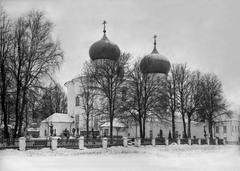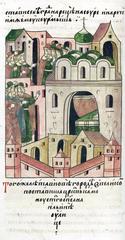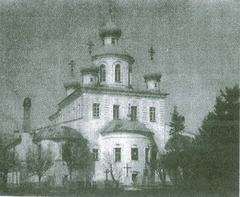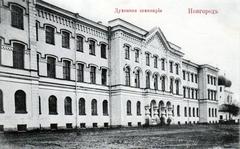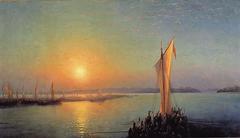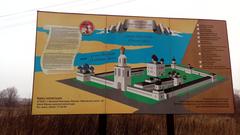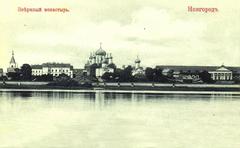Novgorodskiĭ Gosudarstvennyĭ ObʺEdinennyĭ Muzeĭ Zapovednik
Novgorodskiy Gosudarstvennyy Obedinyonnyy Muzei-Zapovednik: Complete Visiting Hours, Tickets, and Travel Guide
Date: 14/06/2025
Introduction
Nestled in the historic heart of Veliky Novgorod, the Novgorodskiy Gosudarstvennyy Obedinyonnyy Muzei-Zapovednik—also known as the Novgorod State United Museum-Reserve—is a living chronicle of Russian civilization. Spanning more than a millennium, this museum-reserve integrates some of Russia’s most iconic medieval architectural sites, extensive collections of artifacts, and vibrant living traditions. Visitors are invited to explore the birthplace of Russian statehood, wandering through the Kremlin (Detinets), Saint Sophia Cathedral, the open-air Vitoslavlitsy Museum of Wooden Architecture, and numerous churches and monasteries that together showcase the evolution of Russian art, spirituality, and daily life (UNESCO, Novgorod.ru, TravelSetu).
This guide provides detailed information on the museum-reserve’s historical significance, visiting hours, ticket options, accessibility, and travel tips—ensuring a rewarding experience for every visitor, whether you are a seasoned historian, a cultural traveler, or a family exploring Russian heritage (Lonely Planet, ibnbattutatravel).
Quick Contents
- Historical Background & Significance
- Major Sites and Highlights
- Visiting Hours & Ticketing
- Accessibility & Visitor Services
- Travel, Tips, and Recommended Itineraries
- Frequently Asked Questions (FAQ)
- Conclusion
- Sources & Further Reading
Historical Background & Significance
Origins and Historical Development
Veliky Novgorod is one of Russia’s oldest cities, with records dating back to the 9th century. It rose to prominence as a major political and cultural center on ancient trade routes, playing a foundational role in the Old Russian state and the rise of the Rurikid dynasty (UNESCO, Novgorod.ru). Governed by its unique People’s Assembly (Veche), Novgorod fostered civic autonomy and was known for its advanced political culture.
Artistic and Architectural Heritage
The museum-reserve safeguards the largest concentration of medieval Russian architecture, including UNESCO World Heritage monuments such as the Novgorod Kremlin (Detinets), Saint Sophia Cathedral (1045–1050), and the Church of Our Saviour on Nereditsa (UNESCO, VisitRussia). The city is revered for its frescoes by Theophanes the Greek and for an unparalleled collection of icons spanning the 11th to 19th centuries (Lonely Planet).
Literacy, Learning, and Daily Life
Novgorod was a medieval center of literacy, with schools established as early as the 11th century. Archaeological excavations have yielded over 1,000 birch-bark manuscripts—testimony to a literate society that included merchants, artisans, and even children (Novgorod.ru, UNESCO). The museum’s archaeological and ethnographic collections bring this vibrant urban life to the present.
Major Sites and Highlights
Novgorod Kremlin (Detinets)
- Saint Sophia Cathedral: The oldest stone church in Russia, home to 11th-century frescoes, the renowned bronze Magdeburg doors, and a historic iconostasis (UNESCO).
- Millennium of Russia Monument: Erected in 1862, this grand bronze sculpture features over 100 celebrated figures in Russian history (Wanderlog).
Vitoslavlitsy Museum of Wooden Architecture
An open-air museum featuring authentic wooden churches, peasant homes, and windmills relocated from the Novgorod region. Experience folk crafts through live demonstrations and seasonal festivals (TravelSetu).
Yaroslav’s Court & Ancient Trade Mart
Explore Novgorod’s trading history at this riverside ensemble, including the 12th-century St. Nicholas Cathedral with its original frescoes and the reconstructed medieval Trade Mart.
Yuriev (St. George’s) Monastery
Founded in the 12th century, this spiritual complex offers beautiful grounds, the Romanesque St. George’s Cathedral, and exhibitions on monastic life.
Pogankiny Palaty
This rare 17th-century merchant mansion houses collections of fine arts, silverwork, and archaeological finds, reflecting Novgorod’s commercial wealth (Culture Tourist).
Visiting Hours & Ticketing
Opening Hours
- Main Sites (Kremlin, Saint Sophia Cathedral, Vitoslavlitsy): Typically open daily from 10:00 AM to 6:00 PM; closed on Mondays or for scheduled maintenance.
- Other Sites: Hours vary—confirm on the official website or by phone before your visit.
Ticket Information
- Standard Adult Tickets: 300–600 RUB per site.
- Combined Tickets: 700–1000 RUB, covering multiple locations.
- Discounts: Available for students, seniors, and children.
- Purchase: At site entrances or online via the official museum website.
- Audio Guides: Available in multiple languages for a small additional fee.
Accessibility & Visitor Services
- Accessibility: Key exhibition halls and visitor centers are wheelchair accessible. Some historic buildings (e.g., wooden churches, towers) have stairs or uneven surfaces.
- Guided Tours: Offered in Russian, English, German, and French. Book in advance for group or themed tours.
- Amenities: Restrooms, cloakrooms, cafés, and gift shops available at main sites.
- Photography: Allowed in most areas without flash; restrictions may apply in sacred spaces or special exhibitions.
Travel, Tips, and Recommended Itineraries
- Getting There: Veliky Novgorod is connected by train and bus to St. Petersburg (3–4 hours) and Moscow. The city center and Kremlin are walkable; taxis and local buses reach outlying museums.
- Best Visiting Time: Late spring to early autumn (May–September) for mild weather and outdoor events.
- Suggested Duration: At least one full day for the Kremlin and city center; add a half-day for Vitoslavlitsy and Yuriev Monastery.
- Dining: Sample local specialties in nearby cafés—try honey mead (medovukha) and Novgorod pies.
- Cultural Etiquette: Dress modestly in churches; women may need to cover their heads. Maintain quiet in places of worship.
Frequently Asked Questions (FAQ)
Q: What are the museum’s visiting hours?
A: Main sites are open 10:00–18:00, closed Mondays. Last admission is typically 30–60 minutes before closing (Novgorodmuseum.ru).
Q: How do I buy tickets?
A: Tickets are available at museum entrances and online. Combined tickets offer savings for multiple sites.
Q: Are guided tours available in English?
A: Yes, advance booking is advised.
Q: Is the museum accessible to visitors with disabilities?
A: Main buildings are accessible; some historic structures may be less so due to preservation needs.
Q: Can I take photos?
A: Non-flash photography is generally permitted, but restrictions apply in certain exhibits and sacred spaces.
Conclusion
The Novgorod State United Museum-Reserve is a window into the origins and evolution of Russian civilization. Its blend of UNESCO-listed monuments, rich collections, and living traditions offers visitors both depth and diversity. Plan ahead by checking the official website for updated schedules and ticketing, and consider joining a guided tour for a fuller appreciation of Novgorod’s legacy. For exclusive audio guides, event news, and travel content, download the Audiala app and follow us on social media.
Sources & Further Reading
- Historic Monuments of Novgorod and its Surroundings, 1992, UNESCO (UNESCO)
- Veliky Novgorod History and Information, Novgorod.ru (Novgorod.ru)
- Novgorod State United Museum and Attractions, Lonely Planet (Lonely Planet)
- Veliky Novgorod Tourism Guide, TravelSetu (TravelSetu)
- Veliky Novgorod Map and Museum Info, Wanderlog (Wanderlog)
- Novgorod State United Museum Official Site, 2025 (Novgorodmuseum.ru)
- Veliky Novgorod Explored: Landmarks and Archaeological Sites, ibnbattutatravel (ibnbattutatravel)
- Searching for Old Russia: Visiting Veliky Novgorod and Pskov, Culture Tourist (Culture Tourist)
Image suggestions:
- Novgorod Kremlin, alt: “Novgorod Kremlin, a UNESCO World Heritage Site in Veliky Novgorod”
- Saint Sophia Cathedral interior, alt: “Interior frescoes of St. Sophia Cathedral”
- Vitoslavlitsy open-air museum, alt: “Historic wooden church at Vitoslavlitsy Museum of Wooden Architecture”
- Millennium of Russia monument, alt: “Monument Millennium of Russia in Novgorod Kremlin”
